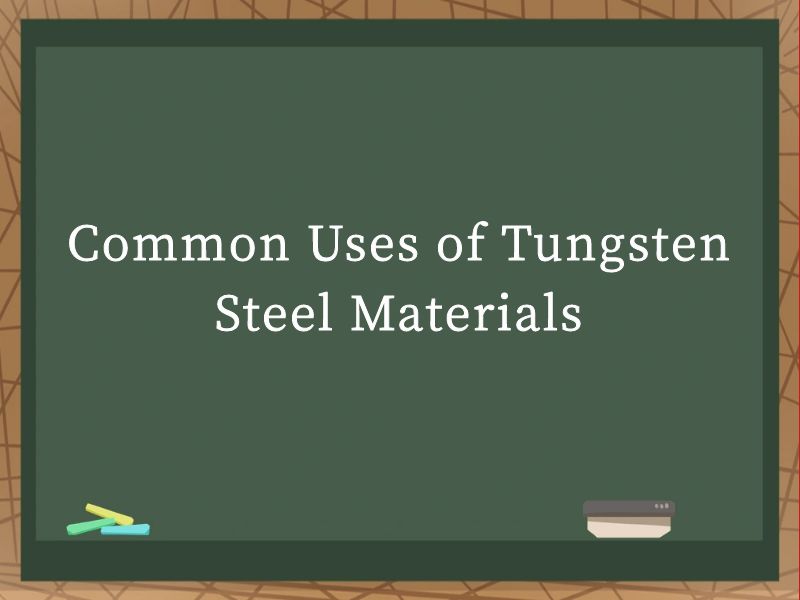JOURNALISM
- NEWS -
|
Common Uses of Tungsten Steel MaterialsCommon Uses of Tungsten Steel Materials.Tungsten steel, also known as tungsten carbide (WC), is a hard, wear-resistant material composed primarily of tungsten and carbon. This alloy possesses exceptional properties that make it ideal for various industrial and manufacturing applications. Its unique combination of hardness, density, and thermal stability sets it apart from other materials, enabling it to perform under extreme conditions. This article explores the common uses of tungsten steel materials across different sectors, highlighting the versatility and reliability of this remarkable material.
1. Mining and Drilling Equipment In the mining industry, tools and equipment must endure significant wear and tear due to the abrasive nature of rocks and minerals. Tungsten steel's hardness and wear resistance make it a natural choice for mining and drilling applications. Drill bits, cutting tools, and end mills crafted from tungsten steel can withstand the friction and pressure associated with drilling through hard rock formations. These tools maintain their sharpness longer, reducing the frequency of replacements and downtime. Moreover, tungsten steel's high density contributes to its excellent impact resistance, allowing it to perform reliably even in demanding environments. This makes it ideal for use in underground mining, where equipment must navigate tight spaces and endure constant exposure to harsh conditions. The durability of tungsten steel tools helps to improve operational efficiency and reduce maintenance costs, making it a valuable asset in the mining industry. 2. Machining and Tool Manufacturing The machining industry relies heavily on precision and accuracy to produce high-quality parts and components. Tungsten steel's exceptional hardness and wear resistance make it an essential material for manufacturing cutting tools, such as milling cutters, lathe tools, and reamers. These tools can maintain their sharpness and precision over extended periods, ensuring consistent results and minimizing waste. In addition to its hardness, tungsten steel's ability to retain its properties at high temperatures makes it suitable for machining applications that involve high-speed cutting or heavy loads. This allows manufacturers to increase production rates and improve the overall quality of their products. The use of tungsten steel tools in machining operations also leads to reduced tool wear and longer tool life, translating to lower operational costs and improved profitability. 3. Wear Parts and Components In many industrial settings, equipment and machinery are subject to constant wear and tear. Tungsten steel's wear resistance makes it an ideal material for manufacturing wear parts and components that are exposed to abrasive or erosive conditions. Examples include bearings, seals, and valve seats in pumps and compressors, as well as wear plates and liners in mining and construction equipment. By using tungsten steel for these applications, industries can significantly extend the lifespan of their equipment and reduce the frequency of repairs and replacements. This not only leads to cost savings but also minimizes disruptions to operations and maintains productivity levels. Tungsten steel's high density and hardness also contribute to its ability to withstand impact and wear, ensuring reliable performance even in the most demanding environments. 4. Aerospace and Defense The aerospace and defense industries demand materials that can withstand extreme conditions, including high temperatures, pressure, and mechanical stress. Tungsten steel's combination of hardness, density, and thermal stability makes it a suitable choice for components in these sectors. For instance, tungsten steel is used in the manufacturing of engine parts, such as turbine blades and nozzles, where it can withstand the high temperatures and corrosive environments associated with jet engines. Additionally, tungsten steel's high density and hardness make it an excellent material for armor applications. Its ability to resist penetration and deformation provides enhanced protection against projectiles and blast forces, making it an essential component in military vehicles and personal protective equipment. The versatility and reliability of tungsten steel make it an indispensable material in the aerospace and defense industries, contributing to the safety and performance of critical systems and components. 5. Medical Applications Tungsten steel's unique properties also make it suitable for medical applications, particularly in the field of surgical instruments. Its hardness and wear resistance ensure that surgical tools maintain their sharpness and precision throughout their lifespan, enabling surgeons to perform delicate procedures with confidence. Tungsten steel's corrosion resistance also makes it an ideal material for medical implants and other devices that must endure long-term exposure to bodily fluids and tissues. Furthermore, tungsten steel's high density and machinability allow manufacturers to produce intricate and precise medical components, such as needles, guides, and stents. These components can be designed to meet specific requirements, ensuring optimal performance and patient outcomes. The use of tungsten steel in medical applications underscores its versatility and ability to meet the stringent demands of the healthcare industry. 6. Electronics and Semiconductor Manufacturing In the electronics and semiconductor industries, precision and cleanliness are paramount. Tungsten steel's hardness, wear resistance, and machinability make it an ideal material for manufacturing tools and components used in these sectors. For instance, tungsten steel is used in the production of diamond-coated cutting tools for slicing silicon wafers, which are essential for the manufacture of semiconductors. Additionally, tungsten steel's corrosion resistance and high density make it suitable for use in vacuum chambers and other components that require high levels of purity and stability. These properties ensure that tungsten steel components can withstand the extreme conditions associated with semiconductor manufacturing processes, such as high temperatures and plasma etching. The reliability and precision of tungsten steel tools and components contribute to the efficiency and quality of electronics and semiconductor manufacturing, driving innovation and progress in these industries. 7. Jewelry and Watchmaking Tungsten steel's high density and hardness make it an attractive material for jewelry and watchmaking. Its ability to resist scratches and tarnishing ensures that tungsten steel jewelry and watches maintain their shine and appearance over time. Tungsten steel's heavy weight and sleek appearance also appeal to consumers seeking durable and stylish accessories. In the watchmaking industry, tungsten steel is used to produce high-precision components, such as gears and springs, that must withstand constant wear and maintain accurate timing. Its machinability allows manufacturers to produce intricate designs and finishes, catering to the discerning tastes of luxury watch enthusiasts. The use of tungsten steel in jewelry and watchmaking underscores its aesthetic appeal and ability to meet the rigorous demands of these industries. Tungsten steel's exceptional properties make it a versatile and reliable material for a wide range of applications. From mining and drilling equipment to medical instruments and jewelry, tungsten steel's hardness, wear resistance, and thermal stability ensure that it performs reliably under extreme conditions. Its ability to meet the stringent demands of various industries underscores its value as a material of choice for manufacturers and engineers. As technology and innovation continue to advance, the uses of tungsten steel are likely to expand, further demonstrating its versatility and potential. |


